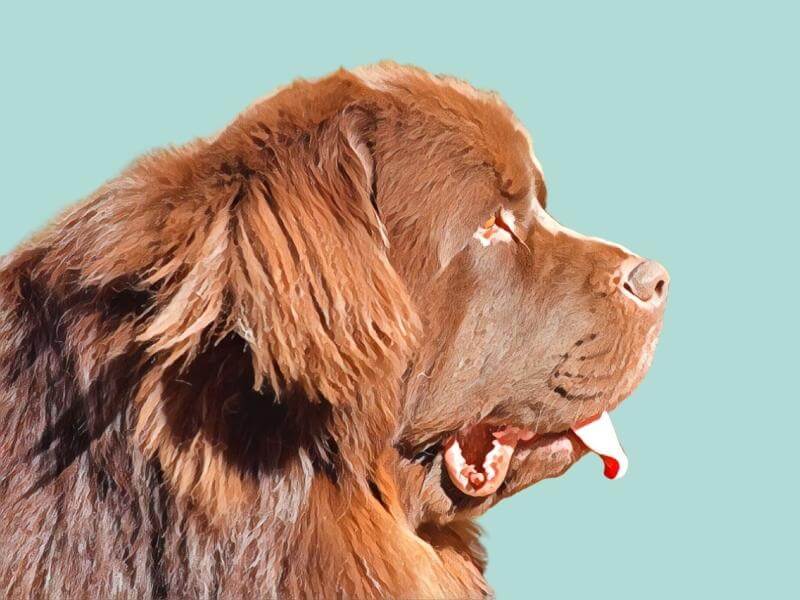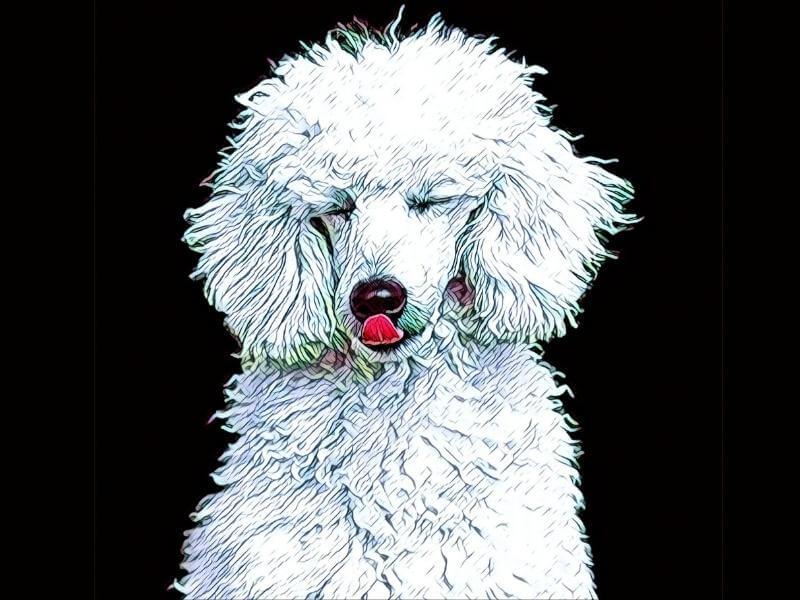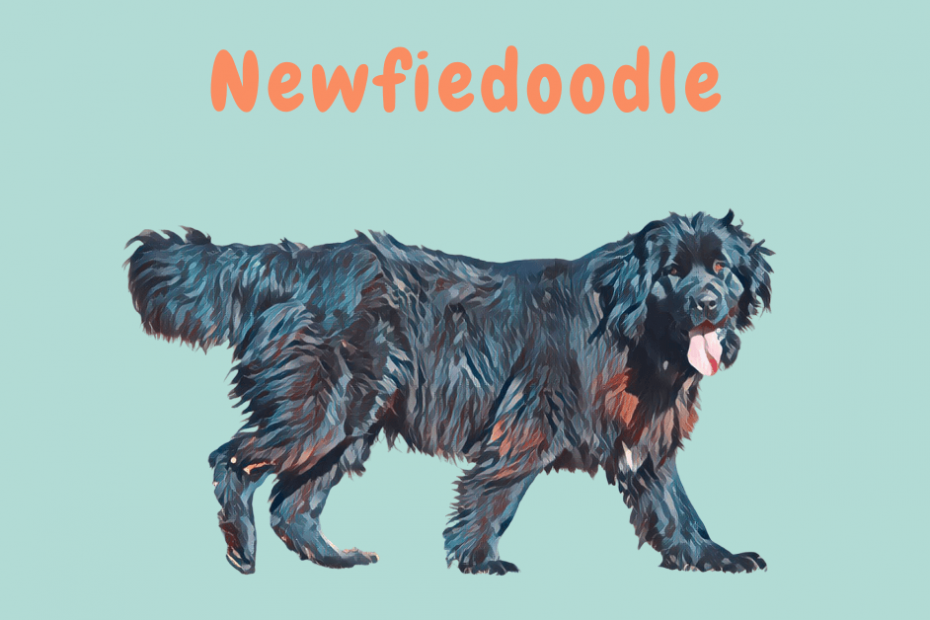A Newfiedoodle (aka Newfypoo) is a crossbreed between a Standard Poodle and a Newfoundland.
They are a reasonably new designer Doodle breed but are lovely, lovable, gentle-giant hybrid dogs with unique characteristics.
If you want to learn more about these massive doods, check out this ultimate in-depth guide! I will discuss everything you need to know about this lovely breed.
An Introduction To Newfiedoodles
Considered the most loveable gentle giants, these beautiful Newfiedoodles have made quite an impression upon their arrival in this world. They are incredibly loyal and have a very docile nature.
Newfiedoodles were bred to have a large dog with the intelligence, trainability, and low-shedding coat of a Standard Poodle and the size and temperament of a Newfoundland dog.
Since the Newfiedoodle is a Poodle-mix, it is considered a Doodle breed. If both parents are purebred dogs, the resulting litter is classified as an F1 (or first generation) Newfiedoodle.
They can be referred to as a Newfiedoodle, Newfydoodle, Newfiepoo, Newfypoo, or Newdle.
They are perfect for owners who are allergic to dog dander. They are also ideal for families that love cuddly, big dogs.
Before you decide if they’re the right pup for you, I’ll take a deep dive into their appearance, temperament, health, price, and so much more!
First, check out this Newfypoo video!
[lyte id=’CysSn374Zng’ /]
Popularity
Newfiedoodles are a relatively new breed, and it is hard to know exactly how popular they are throughout the globe. However, with their excellent temperaments, health, size, energy, and affectionate natures, Newfiedoodles are becoming increasingly popular among dog lovers.
Hybrid breeds, in general, have become a big part of modern society because they have better health records and are lower maintenance than purebreds.
History of Newfiedoodles
Newfiedoodles are believed to have originated in the United States. Unfortunately, like many first-generation crossbreeds, the Newfiedoodle’s exact origin is unknown.
We know that the breed officially started to be recognized and recorded by the International Designer Canine Association in 2009.
It is believed that Cockapoos were actually the first Poodle hybrid breed in the 1950s [1]www.hillspet.com/dog-care/dog-breeds/cockapoo. It is suspected that Newfiepoodles, or Newfiepoos, were also one of the first Poodle mixes, sometimes referred to as hybrid designer dogs.
They were initially named Newfiepoos, but after Labradoodles became the next hype in 1988, they ditched the “poo” terminology and replaced it with the “doodle” terminology. Since then, every Poodle hybrid has been referred to as part of the Doodle “designer dog” breed.
The Newfoundland

The Newfoundland dog breed originated in Newfoundland, Canada. There is no surprise about where they got their name from…
They were bred to help bring in fisherman’s nets. They were also used to pull things around town using a cart.
Newfoundland dogs have a double coat that protects them from cold water. This enabled them to assist in water rescue in the frigid waters of the Labrador Sea. A skill they still are used for today.
Despite their gigantic size, they have a sweet and gentle temperament. They love being around their owners at all times.
The Poodle

The Standard Poodle, on the other hand, is the national dog of France, even though the breed originated in Germany. Poodles were bred for hunting purposes more than 400 years ago.
Specifically, they were bred to be water-fowl hunters and retrievers. This enabled them to evolve as strong, athletic, and intelligent dogs. They are eager to learn and perform specific duties, which means they respond well to training.
Because of their high intelligence and athleticism, they became popular circus performers in France, which led to the creation of Miniature Poodles.
Smaller Poodles were as intelligent as Standard Poodles but lighter, smaller, and easier to travel. In America, Mini Poodles were eventually bred down in size to create the Toy Poodle.
Newfypoo Appearance
Not all Newfiedoodles look the same. They can have different colors and coats depending on their parents and which of the two breeds is most dominant. Let’s look at the coat types and colors of the Newfiedoodle hybrid.
Coat Type
Each Doodle owner will agree how convenient it is to have a low-shedding dog because less hair equals less cleaning.
They generally have soft, fluffy, and curly fur; however, a Newfoundland dog’s oily, water-resistant coat has been reported to have been passed on to some of its hybrid offspring.
Regular grooming and brushing become necessary as an oily, thick coat is more prone to pick up dirt. Some owners have claimed that their Newfiedoodles leave oil stains on walls and furniture.
Luckily, most of these hybrids adopt the low-shedding, non-oily coat of the Standard Poodle in the mix.
Mixing in a monthly bath is an excellent idea to keep that dense coat from accumulating too much dirt!
Colors
There is no standard color for a Newfiedoodle, and it is tough to determine what the offspring will look like. The best way to predict the color of the unborn puppies is by looking at the parents’ colors.
Newfiedoodles can be born with all sorts of colors: black and brown patches, black, black and white, dark head with a light body, golden-brown cream, black and brown, and one color all over, such as black, beige, white, and cream.
They can also have unique coloring such as merle, phantom, tri-color, parti, etc.
For example, check out this merle Newfypoo below:
Here is an example of a parti Newfypoo coat:
Different Sizes of A Newfiedoodle
Knowing the adult size of a puppy and if available space in your home will be enough is essential. Luckily, Newfiedoodles come in standard and mini sizes, enabling you to choose the correct sized dog.
The standard size is more akin to the large size regarding dog classification. This is mainly based on the Newfoundland parent since they are such a large dog breed.
Standard Size
- Weight: 65 to 130 lbs
- Height: 22 to 25″
Mini Size
- Weight: 35 to 65 lbs
- Height: 18 to 21″
A Mini Newfiedoodle is closer to the size of a Standard Poodle, whereas a Standard Newfiedoodle can reach a height of 28″ and weigh as much as 150 lbs.
Temperament
A Newfiedoodle is known to have a sweet, calm spirit, and while they are not typically hyperactive dogs, they need enough room to move around and stretch their legs. They also require daily walks to strengthen muscles and maintain a healthy weight.
They are incredibly affectionate, and their loyalty makes them easy to train. The only time you will see a Newfiedoodle’s teeth come out is when they are protecting their owners or homes, but overall, they are fun-loving, kind, and gentle dogs.
Their love for their owners can sometimes result in separation anxiety, and they become extremely distressed when their owners have to leave them at home alone. It can be so traumatic that they act out by chewing things, digging holes, and barking non-stop.
Below is a summary of the traits and characteristics of the Newfoundland-Poodle mix. The categories are averages taken from the American Kennel Club [2]www.akc.org/dog-breeds/poodle-standard,[3]www.akc.org/dog-breeds/newfoundland.

One smart Doodle cookie
With parent breeds like the Newfoundland dog and Poodle, it comes as no surprise that their hybrid offspring are an intelligent breed.
These dog breeds can be trained to do multiple tricks, among other things, and they love to please their owners with their performance.
Newfiedoodles are eager to learn, and training them is a walk in the park; they are more likely to excel in training than other dog breeds. Just keep treats nearby to reward them for their competence and achievements.
As an intelligent dog, you better keep your eye out for any mischief!
Health
Hybrids are generally recognized as less susceptible to diseases and other health issues.
However, since their parents are purebreds, some conditions remain hereditary but compared to purebreds, they have much better health.
Newfiedoodles can experience the following health conditions:
- Joints: Elbow & hip dysplasia, patellar luxation.
- Eye Diseases: Cataracts, Cherry Eye, progressive retinal atrophy (PRA), glaucoma.
- Thyroid Disorder
- Bone Density Issues
- Heart Problems: Dilated cardiomyopathy, subaortic stenosis.
- Brain: Epilepsy
- Other: Bloat (common in large breed dogs), diabetes, sebaceous adenitis.
Knowing the parents’ medical history can reduce or prevent these health conditions and complications. It is vital to remember that our pets are at our mercy, and our responsibility is to take them for regular veterinarian check-ups.
General Care
As with any breed, grooming is necessary. However, a Newfiedoodle’s thick, curly coat needs a little extra tender love and care. To avoid knots and dirt build-up, give your fluffy friend a daily brushing (or as much as possible).
You may have realized that your Newfie likes to get muddy and dirty any chance he gets. If you have a mud-loving pup, you will need to bathe him often; otherwise, the mud will harden into clumps and be challenging to get out of their thick fur.
They also require regular trimming because, unlike other dogs, their hair continues growing. You may find it a bit too difficult to tame your dog’s thick, curly hair by yourself, so it would be a great idea to take them to a professional dog groomer instead.
It can be a bit pricy, but they do everything from bathing your dog to conditioning them, grooming, cleaning their ears, and even trimming their nails.
These large dogs require around 60 minutes of walking daily, especially for dogs that do not have too much room to run at home. A brisk walk of half an hour out and back should be enough to loosen their joints and work their muscles.
How much do Newfypoo puppies cost?
Depending on the breeders, Newfypoo puppies can cost between $500-$1,600. This is only their purchase price, not to mention their expensive feeding standards, grooming costs, treats, pet sitters, and vet bills.
No matter the price, please be sure you are choosing a reputable breeder. This takes some research and effort, but it will pay off in the end!
If you want a Newfiedoodle, it would be best to see if your budget will allow for such expenses and if you should settle for a lower-maintenance pooch instead.
Fun Facts About Newfiedoodles
- The most common Newfiedoodle colors are black & white, black, and chocolate & white.
- Compared to the original Labradoodle, Newfiedoodles are larger, calmer, and have blockier head shapes.
- Like most all Doodle breeds, Newfiedoodles love water!
- When Goldendoodle or Labradoodle owners want a giant dog, they usually get a Newfiedoodle.
- An F1 Newfiedoodle is a perfect balance of 50% Poodle and 50% Newfoundland.
- Newfiedoodles are generally easier to train than purebred Newfoundlands
- Due to their hybrid vigor, they are less prone to health problems.
- A Newfiedoodle has had many names: Newfoundlandpoos, Newdles, Newfypoos, Newfydoodles, Poofoundlands, Newfiepoos, and Newfoundlanddoodles.
- Newfiedoodles don’t drool as much as the Newfoundland breed.
- Newfiepoos have a hypoallergenic coat.
FAQs
Many people want to know more about these beautiful dogs, so we have decided to answer a few of their Newfiedoodle questions below.
Are Newfiedoodles good with young children?
Newfiedoodles are excellent dogs for children due to their docile nature. Not only are they protective, but they’re very interactive and playful with kids while also being exceptionally gentle towards them.
These magnificent dogs grow fond of their little people as if they were their offspring. They are incredibly aware of their size and handle adults and children with different roughness levels.
It is, however, crucial to teach young children how to treat animals and when to give them their space. After all, they are still only animals and have defense mechanisms to protect themselves from harm, like children pulling their tails or ears.
How long do Newfiedoodles live?
A dog owner’s biggest wish is that their best friend will live a long and prosperous life. While some dogs will live longer than others, sadly, the expected lifespan of a Newfiedoodle is only 8 to 12 years, and the larger the breed, the shorter their lifespan.
Do Newfiedoodles bark a lot?
Even though they have a booming bark, Newfiedoodles are not considered excessive barkers; this is great for safety reasons because their owners will know they are barking to warn them about something that might not be right.
They could be trying to warn their owners of a fire or if they sense an intruder. Their deep, loud bark is enough to scare any intruder away as they can hear that a big dog is protecting the property.
The low-barking tendency is also fantastic news for neighbors as they can get rather annoyed if you have a dog that barks all through the day and at night – bottom line, these dogs bark for a good reason.
Do Newfiedoodles make good watchdogs?
Newfiedoodles make excellent watchdogs due to their protective nature. Thanks to their part Newfoundland heritage, they have adopted a protective instinct because Newfoundlands were used to protect farmsteads and livestock.
Luckily this protective trait has passed down to their offspring, and many owners admit they wanted a Newfiedoodle solely for that purpose. So, with some training, you will have a brilliant watchdog!
Do Newfiedoodles drool a lot?
Most Newfiedoodles don’t have the low-hanging jowls of Newfoundland. They have smaller mandibles, which means less drooling.
Conclusion
A Newfiedoodle will bring love, fun, and cuddles into any family that adopts them. Their loyalty is inspiring, and despite being a little high-maintenance, they are more than worth the effort.
While they are relatively new to the Doodle family, they are fast becoming one of the most popular, in-demand breeds, and it is easy to see why! If you want a unique addition to your family, a Newfiedoodle is the one for you.
Now, it’s time to go pick out your Newfypoo puppy!
- If you’re looking for a smaller Doodle breed, check out this entire guide to all types of different Doodle dogs.


